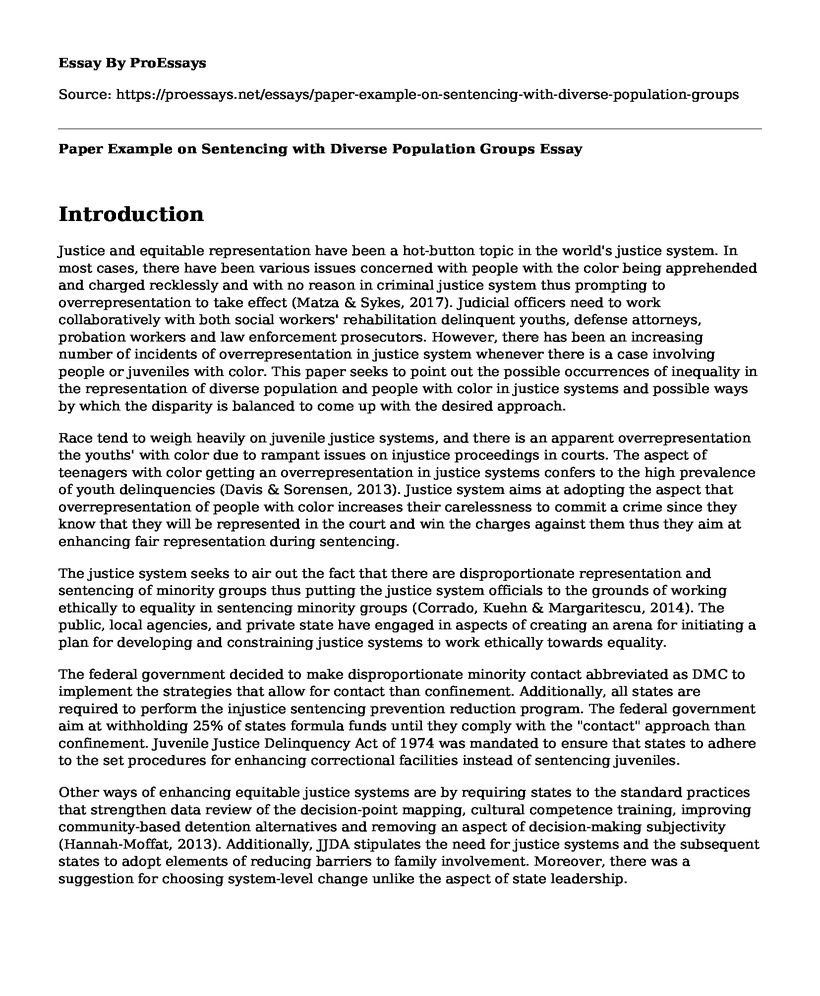Introduction
Justice and equitable representation have been a hot-button topic in the world's justice system. In most cases, there have been various issues concerned with people with the color being apprehended and charged recklessly and with no reason in criminal justice system thus prompting to overrepresentation to take effect (Matza & Sykes, 2017). Judicial officers need to work collaboratively with both social workers' rehabilitation delinquent youths, defense attorneys, probation workers and law enforcement prosecutors. However, there has been an increasing number of incidents of overrepresentation in justice system whenever there is a case involving people or juveniles with color. This paper seeks to point out the possible occurrences of inequality in the representation of diverse population and people with color in justice systems and possible ways by which the disparity is balanced to come up with the desired approach.
Race tend to weigh heavily on juvenile justice systems, and there is an apparent overrepresentation the youths' with color due to rampant issues on injustice proceedings in courts. The aspect of teenagers with color getting an overrepresentation in justice systems confers to the high prevalence of youth delinquencies (Davis & Sorensen, 2013). Justice system aims at adopting the aspect that overrepresentation of people with color increases their carelessness to commit a crime since they know that they will be represented in the court and win the charges against them thus they aim at enhancing fair representation during sentencing.
The justice system seeks to air out the fact that there are disproportionate representation and sentencing of minority groups thus putting the justice system officials to the grounds of working ethically to equality in sentencing minority groups (Corrado, Kuehn & Margaritescu, 2014). The public, local agencies, and private state have engaged in aspects of creating an arena for initiating a plan for developing and constraining justice systems to work ethically towards equality.
The federal government decided to make disproportionate minority contact abbreviated as DMC to implement the strategies that allow for contact than confinement. Additionally, all states are required to perform the injustice sentencing prevention reduction program. The federal government aim at withholding 25% of states formula funds until they comply with the "contact" approach than confinement. Juvenile Justice Delinquency Act of 1974 was mandated to ensure that states to adhere to the set procedures for enhancing correctional facilities instead of sentencing juveniles.
Other ways of enhancing equitable justice systems are by requiring states to the standard practices that strengthen data review of the decision-point mapping, cultural competence training, improving community-based detention alternatives and removing an aspect of decision-making subjectivity (Hannah-Moffat, 2013). Additionally, JJDA stipulates the need for justice systems and the subsequent states to adopt elements of reducing barriers to family involvement. Moreover, there was a suggestion for choosing system-level change unlike the aspect of state leadership.
Conclusion
In summation, this paper has pointed out the possible incidents of inequality in the representation of diverse population and people with color in justice systems and possible ways by which the disparity is balanced through the desired developed concepts by the federal government and JJCDA (Bradford, 2014). Additionally, it has been outlined that the possible way to reduce the disparity is by adopting the contact than confinement as the main ways of reducing the rampant unjust aspects in the sentencing of individuals with color. The adoption of Contact instead of detention provides grounds for lowering overrepresentation in courts.
References
Bradford, B. (2014). Policing and social identity: Procedural justice, inclusion and cooperation between police and public. Policing and society, 24(1), 22-43.
Corrado, R. R., Kuehn, S., & Margaritescu, I. (2014). Policy issues regarding the overrepresentation of incarcerated aboriginal young offenders in a Canadian context. Youth Justice, 14(1), 40-62.
Davis, J., & Sorensen, J. R. (2013). Disproportionate minority confinement of juveniles: A national examination of Black-White disparity in placements, 1997-2006. Crime & Delinquency, 59(1), 115-139.
Hannah-Moffat, K. (2013). Actuarial sentencing: An "unsettled" proposition. Justice Quarterly, 30(2), 270-296.
Matza, D., & Sykes, G. M. (2017). Techniques of neutralization: A theory of delinquency. In Delinquency and Drift Revisited, Volume 21 (pp. 33-41). Routledge.
Cite this page
Paper Example on Sentencing with Diverse Population Groups. (2022, May 03). Retrieved from https://proessays.net/essays/paper-example-on-sentencing-with-diverse-population-groups
If you are the original author of this essay and no longer wish to have it published on the ProEssays website, please click below to request its removal:
- Paper Example on Minors in the Legal System
- The Sovereignty of Divine Law Over Civil Law in Antigone: Critical Essay Sample
- Essay Example on Freedom of Expression: From Ancient Times to Contemporary Society
- Privacy: The Dangers of Overexposing Personal Information - Essay Sample
- Paper Example on Nissan Suing Carlos Ghosn: $90M Fraud Scandal & Escape to Lebanon
- 'Courts Grant Offenders Rights: Slowing Down Investigation?' - Essay Sample
- 9/11: How US Policy Changed After Terror Attacks - Essay Sample







